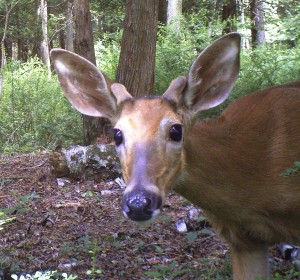 This article was written by Jennifer Powell, our land management coordinator.
This article was written by Jennifer Powell, our land management coordinator.
I have witnessed what I consider an unusual amount of deer-car collisions for this time of year. I usually think of September and October being more of a common time for this unfortunate incident, as deer are more active and the rut is occurring. This peaked my interest into learning more about deer biology. White-tailed deer are mammals common throughout Wisconsin.
The rut, or breeding season of deer, can actually last from October through December. During this time, male deer (bucks) grow antlers out of bone. Antlers attract does (female deer) and are also used to fight with other bucks over territory or does. These antlers are then shed in the winter.
The gestation period in deer is around 200 days (approximately 6.5 months) and does can give live birth to one to three offspring (fawns). One fawn is common with younger does, and twins are average in more mature does. Three fetuses (fawns still inside the doe) require a lot of nutrition, and if the winter is long, cold, and deep with snow, the doe may not have enough food for them all. One result of this is that a fetus may be aborted and reabsorbed, allowing the doe enough nutrition to support her and the remaining two fawns.
Fawns are born in the spring, typically in May and June. Fawns are born with white spots to help them blend in, or camouflage, with their surroundings. When they get their first winter coat, the spots disappear. Does will often leave newborn fawns for short periods of time, so it is important not to take or disturb a fawn which appears to be abandoned. Males usually leave their mother and venture out on their own after one year; females may remain with their mother for up to two years.
Deer are herbivores, consuming grass, tree leaves, berries, and flowering plants in the spring and summer, acorns, grass, and herbs in the fall, and twigs, nuts, fruits and corn in the winter. While we may dislike deer when they eat our favorite flowers out of our garden bed, they serve an important purpose in our ecosystem. Deer help plant populations grow by eating fruit and spreading seeds through digestion. They serve as a food source for predatory animals, such as coyotes and humans. Their fur kept the early settlers warm in the cold winters. They also bring a sense of peace and connection to the natural world if you are lucky enough to come across one in the woods.
